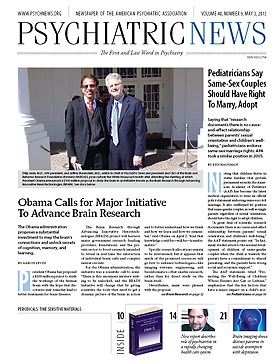Clinicians will see no change in the criteria for personality disorders (PD) in Section II of DSM-5, to be available later this month. But they will find an alternative model for evaluation of PD using a dimensional approach and measures of severity in Section III of the manual. The latter section is reserved for diagnostic material that may need more research and/or more time for clinicians to become acquainted with it, before being included as formal criteria in Section II.
John Oldham, M.D., a past APA president and a member of the Work Group on Personality Disorders, told Psychiatric News that the model of evaluation and diagnosis included in Section III—what he called a “hybrid” of the categorical approach of earlier editions and a new dimensional understanding of personality—is founded on abundant research on personality “traits.” He added that the dimensional framework is also highly relevant for other areas of psychiatric diagnosis.
The approach to personality disorders in the alternative model in Section III embodies some principles that have guided development of DSM-5 from its beginnings: an attempt to develop a model of diagnosis that would address the considerable overlap of symptoms across disorders and the overuse of “not otherwise specified” (NOS) as in DSM-IV.
“From the beginning of the development process for DSM-5, the personality disorders were identified as a place where we needed to move beyond the categorical diagnostic system of discrete disorders in DSM-IV toward a more dimensional system,” Oldham said in an interview. “Personality types, traits, and disorders are on a continuous spectrum, much like blood pressure and hypertension. Too much of a useful, adaptive trait may become a problem.”
Oldham said the work group sought to retain the most familiar and useful aspects of the categorical system to which clinicians were accustomed. The group assembled a large research base to evaluate the construct validity of 10 personality disorders that had been included in DSM-IV, and they recommended retaining the following six: antisocial, avoidant, borderline, narcissistic, obsessive-compulsive, and schizotypal.
The group then created the category called personality disorder–trait specified (PD-TS), which applies to patients who meet the general criteria for a personality disorder but do not have one of the six specified disorders. PD-TS would replace the current PD-NOS category, with the advantage of being not just a PD diagnosis by exclusion, but one that identifies pathological trait profiles. (Using the trait specifiers, clinicians can note symptoms of those other DSM-IV disorders—paranoid, schizoid, histrionic, and dependent—that are not included as specified personality clinical disorders in the Section III alternative model of DSM-5.)
Oldham said the work group then sought to clarify and simplify the personality disorders creating a uniform scheme for criterion A and criterion B that would apply to all the disorders: criterion A describes impairment in “self or interpersonal functioning,” which is broken down into impairment in “identity” and “self-direction” (self) and “empathy” and “intimacy” (interpersonal functioning); criterion B describes pathological personality traits in five broad trait domains: negative affectivity, detachment, antagonism, disinhibition, and psychoticism.
Finally, the alternate model in Section III includes a scale for measuring the level of impairment ranging from 0 (no impairment) to 4 (severe impairment). A diagnosis of one of the personality disorders would require at least a level 2 (“moderate”) category of impairment.
The alternative model is intended to move toward a way of diagnosing disorders that fits the patient who comes to the clinician’s office with a variety of presentations, rather than fitting the individual into a preconceived categorical scheme. Oldham also noted that in the DSM-5 field trials, the model was well received by clinicians and greatly preferred over that in DSM-IV.
He added that what may seem, on the face of it, a “complicated” scheme is in fact far simpler than the categorical criteria for disorders in DSM-IV. Oldham urged clinicians to familiarize themselves with the model and to try using it as a helpful tool in assessing all patients; when they do, they will find it easy and intuitive, he said.
“Once people are familiar with it, they will use it prototypically—that is, clinicians have a prototype or a picture in their head of what the average patient with, say, borderline personality looks like,” he said. “As with almost all disorders, you don’t go through every criterion, but rather you listen and look for the symptoms that are most obvious and that guide you instinctively to the diagnosis that fits the patient.” ■
A fact sheet and audio interview on the alternative model for evaluation of personality disorders can be accessed by going to
http://www.psychiatry.org/dsm5.
